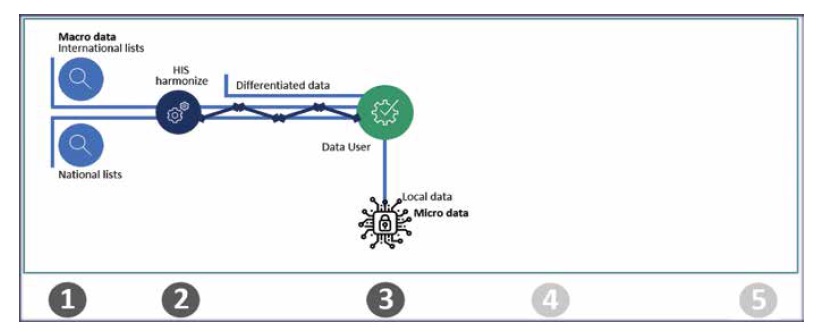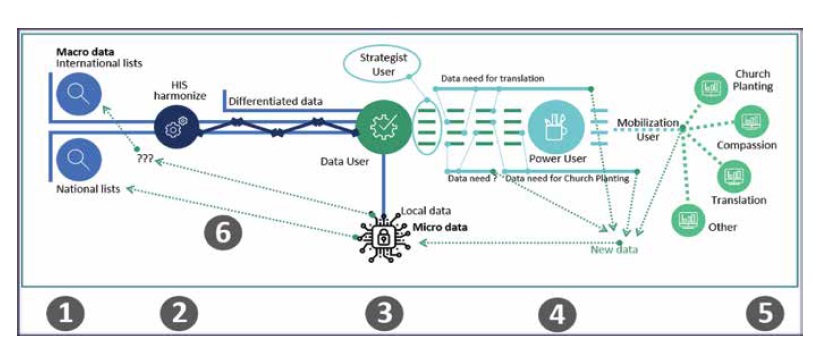More Lists, More Data, More Possibilities

Refining of People Group Information
Latin America has been involved in the global movement of cross-cultural missions for decades. For quite some time we received missionaries from other nations and then by the grace of God, we became involved in sending. The Latin Church was impacted by the lists of people groups (UPGs and UUPGs) it was presented, and today we can identify numerous missionaries with years of cross- cultural field experience who were mobilized by these lists. Even now in 2021, mobilization efforts employ lists among their other varied resources. People group lists have been extremely useful in their roles of shaping understanding, motivating people to pray, challenging people to obey and causing people to go.
Many Latin American ministries are trying to use more data, working under the assumption that more lists and more data give us more possibilities. This assumption needs to be evaluated on the basis of three ideas: First, the design of any workflow is instructive only. Processes are not linear, and they are not circular; they are complex. Second, people groups present themselves differently depending upon who is asking, “Who are you?” There is one response for the government, another for the local church and yet another for other people groups. This should lead us to be creative as to how to represent them. Third, our big goal for “lists or macro data” must be to reveal “hidden people groups.”


People Group Data Workflow: Steps 1-3
Step 1: Lists as macro data
We understand that the international lists of people groups are more like “macro data.” On-site ministry is an environment of constant change. We know that urbanization and globalization are causing rapid change, and they directly impact the creation and implementation of post-arrival field strategies. They also require that new information be collected in the first months on the field. Perhaps ours is just a different planning model. However, while the international lists and the national lists have certainly been used in the preparation and individual decisions of each missionary project, I have no evidence that lists are being used widely in post-arrival strategies employed in Latin America.
Step 2: Lists and harmonization
We usually begin by comparing the internal people group lists of Brazil with international lists. On the one hand, there are discrepancies that, at first, distance the dialogue between the lists. However, after a careful appreciation of both, we manage to reach a good harmonious relationship. Harvest Information Standards (HIS)1 has been one of the tools employed to help harmonize the lists. When I say harmonize, it is not turning two lists into one. We understand that several lists can be helpful and useful, bringing different views and possessing features that allow dialogue between them.
Step 3: Lists and micro data
After achieving an initial harmonization, we then add different data. What we have learned is that the deeper the micro data, the greater the level of security concern. That has a direct relationship to partnerships; the deeper the data, the fewer organizations are willing to join or share. For this reason, we have invested more in macro data as partnerships, and more on micro data as a local organization.
People Group Data Workflow: Complete Process
Step 4: When lists turn into action
Now, with the lists (macro data) and the micro data from the local organization, we have a good place to begin. We look at our challenges and goals, and we choose which information best supports us.
Each challenge requires different extracts of the same information. Power Users are those who understand their ministry and define how to use the information. Power Users include not only the leaders, but also the people on the ground.
In our understanding, it is the Power Users who define to the mobilization ministries which information can be used in their work. For each type of mobilization— church-planting, Bible translation, compassion—we have parts of the data sets that can help. These ministries help refine existing data and provide new local data.
The international lists have followed people group definitions directed by ethnicity and language, and this has been useful. In fact, it is the main model that we, too, have used. However, we have recently been able to experiment with different views of the data (Dataviz2). This allows observing the data not only by ethnicity and language, but also with different variations that better serve the different audiences of organizations and their different ministries.
We are migrating from the use of polygons to points in geography. We are doing some tests between languages in use and different domains. At times we look at clusters of peoples, and we also examine the relationship of the clans within a people group.
Step 5: Local data and security
Everyone participates in how to understand the data, and everyone can be a user of the data. Each ministry can produce new data that is potentially useful in a variety of arenas. Yet it is important when we collect new data from people who have their feet on the ground that their data be treated carefully, observing security requirements.
Step 6: Updating the national and international lists
After the data is carefully cataloged, we can update the lists in collaboration with the global Church. In the case of national lists, the update dialogues are easier. By contrast, for the international lists the update dialogues are still not very clear. A good example of international lists that add value to the local researcher is the Ethnologue. The “data collaborators program”3 provides an instrument that allows the sending of data, the visualization of other collaborators' data and proof of the support of the national research missionary.
In summary, we are using different techniques, strategies and models to try to meet two great objectives. First, we wish to assist the Church to make the most of data for its activities. Second, we want to bring hidden peoples into wider view. We give thanks to God for the servants He has raised up here in Latin America. May He increasingly empower those who are at work today, and may He bring more data missionaries to work for and with them.









comments